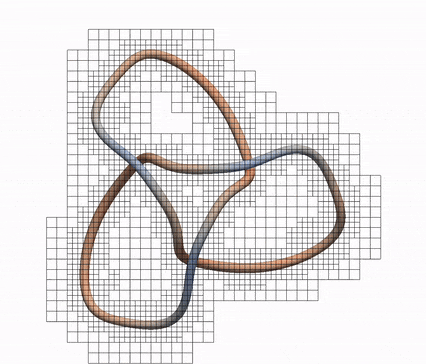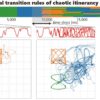In 2018, passengers onboard a flight to Australia experienced a terrifying 10-second nosedive when a vortex trailing their plane crossed into the wake of another flight. The collision of these vortices, the airline suspected, created violent turbulence that led to a free fall.
To help design aircraft that can better maneuver in extreme situations, Purdue University researchers have developed a modeling approach that simulates the entire process of a vortex collision at a reduced computational time. This physics knowledge could then be incorporated into engineering design codes so that the aircraft responds appropriately.
The simulations that aircraft designers currently use capture only a portion of vortex collision events and require extensive data processing on a supercomputer. Not being able to easily simulate everything that happens when vortices collide has limited aircraft designs.
With more realistic and complete simulations, engineers could design aircraft such as fighter jets capable of more abrupt maneuvers or helicopters that can land more safely on aircraft carriers, the researchers said.
Mechanical engineering professor Carlo Scalo and his research team use supercomputers to develop models that efficiently simulate vortex flow phenomena.
“Aircraft in extreme conditions cannot rely on simple modeling,” said Carlo Scalo, a Purdue associate professor of mechanical engineering with a courtesy appointment in aeronautics and astronautics.
“Just to troubleshoot some of these calculations can take running them on a thousand processors for a month. You need faster computation to do aircraft design.”
Engineers would still need a supercomputer to run the model that Scalo’s team developed, but they would be able to simulate a vortex collision in about a tenth to a hundredth of the time using far less computational resources than those typically required for large-scale calculations.
The researchers call the model a “Coherent-vorticity-Preserving (CvP) Large-Eddy Simulation (LES).” The four-year development of this model is summarized in a paper published in the Journal of Fluid Mechanics.
“The CvP-LES model is capable of capturing super complex physics without having to wait a month on a supercomputer because it already incorporates knowledge of the physics that extreme-scale computations would have to meticulously reproduce,” Scalo said.
Former Purdue postdoctoral researcher Jean-Baptiste Chapelier led the two-year process of building the model. Xinran Zhao, another Purdue postdoctoral researcher on the project, conducted complex, large-scale computations to prove that the model is accurate. These computations allowed the researchers to create a more detailed representation of the problem, using more than a billion points. For comparison, a 4K ultra high definition TV uses approximately 8 million points to display an image.
Building off of this groundwork, the researchers applied the CvP-LES model to the collision events of two vortex tubes called trefoil knotted vortices that are known to trail the wings of a plane and “dance” when they reconnect.
This dance is extremely difficult to capture.
“When vortices collide, there’s a clash that creates a lot of turbulence. It’s very hard computationally to simulate because you have an intense localized event that happens between two structures that look pretty innocent and uneventful until they collide,” Scalo said.
Using the Brown supercomputer at Purdue for mid-size computations and Department of Defense facilities for large-scale computations, the team processed data on the thousands of events that take place when these vortices dance and built that physics knowledge into the model. They then used their turbulence model to simulate the entire collision dance.
Engineers could simply run the ready-made model to simulate vortices over any length of time to best resemble what happens around an aircraft, Scalo said. Physicists could also shrink the model down for fluid dynamics experiments.
“The thing that’s really clever about Dr. Scalo’s approach is that it uses information about the flow physics to decide the best tactic for computing the flow physics,” said Matthew Munson, program manager for Fluid Dynamics at the Army Research Office, an element of the U.S. Army Combat Capabilities Development Command’s Army Research Laboratory.
“It’s a smart strategy because it makes the solution method applicable to a wider variety of regimes than many other approaches. There is enormous potential for this to have a real impact on the design of vehicle platforms and weapons systems that will allow our soldiers to successfully accomplish their missions.”
Scalo’s team will use Purdue’s newest community cluster supercomputer, Bell, to continue its investigation of complex vortical flows. The team also is working with the Department of Defense to apply the CvP-LES model to large-scale test cases pertaining to rotorcrafts such as helicopters.
“If you’re able to accurately simulate the thousands of events in flow like those coming from a helicopter blade, you could engineer much more complex systems,” Scalo said.
Researchers compute turbulence with artificial intelligence
More information:
Xinran Zhao et al. Direct numerical and large-eddy simulation of trefoil knotted vortices, Journal of Fluid Mechanics (2021). DOI: 10.1017/jfm.2020.943
Citation:
Turbulence model could help design aircraft capable of handling extreme scenarios (2021, January 21)
retrieved 21 January 2021
from https://phys.org/news/2021-01-turbulence-aircraft-capable-extreme-scenarios.html
This document is subject to copyright. Apart from any fair dealing for the purpose of private study or research, no
part may be reproduced without the written permission. The content is provided for information purposes only.



